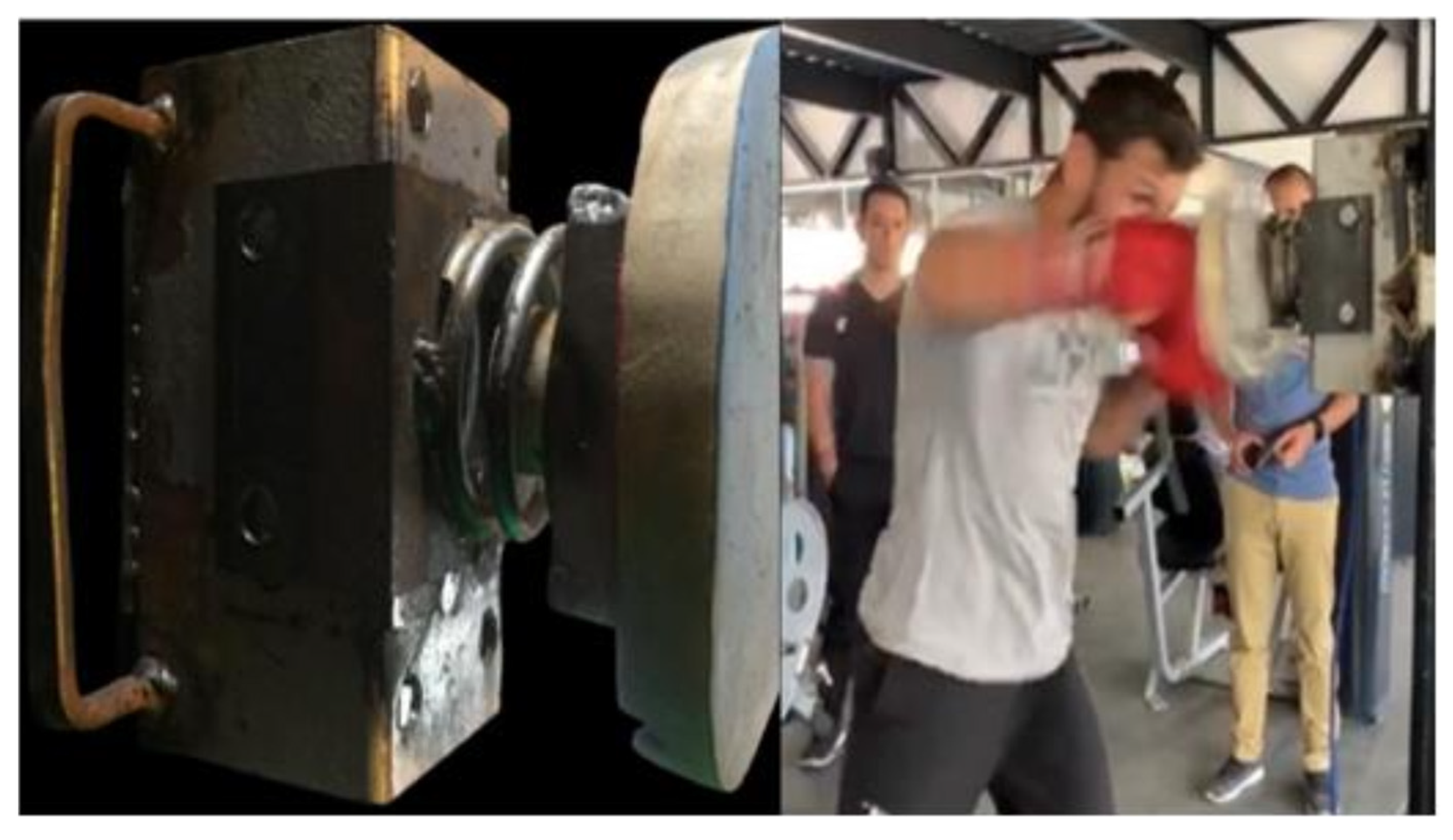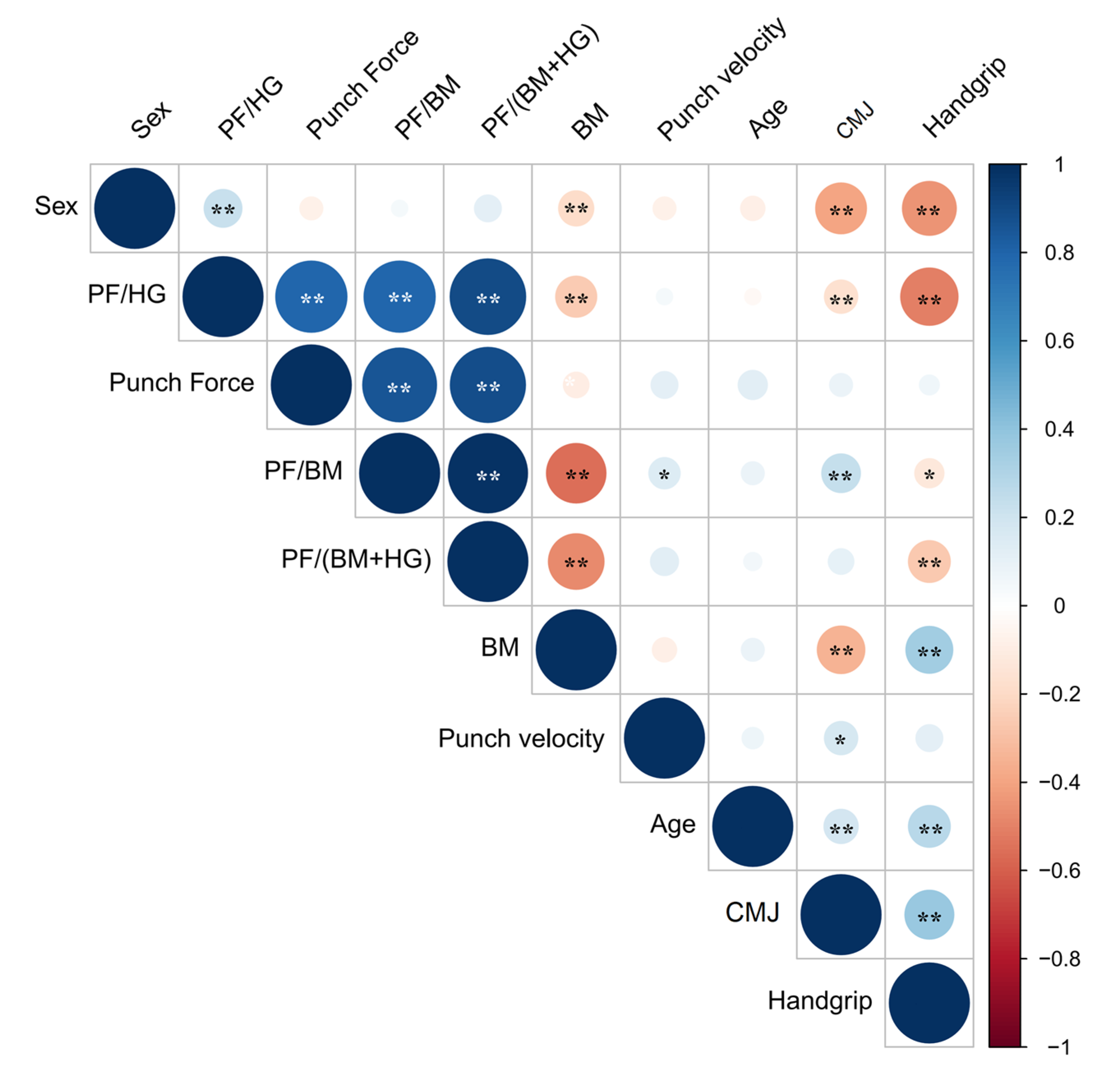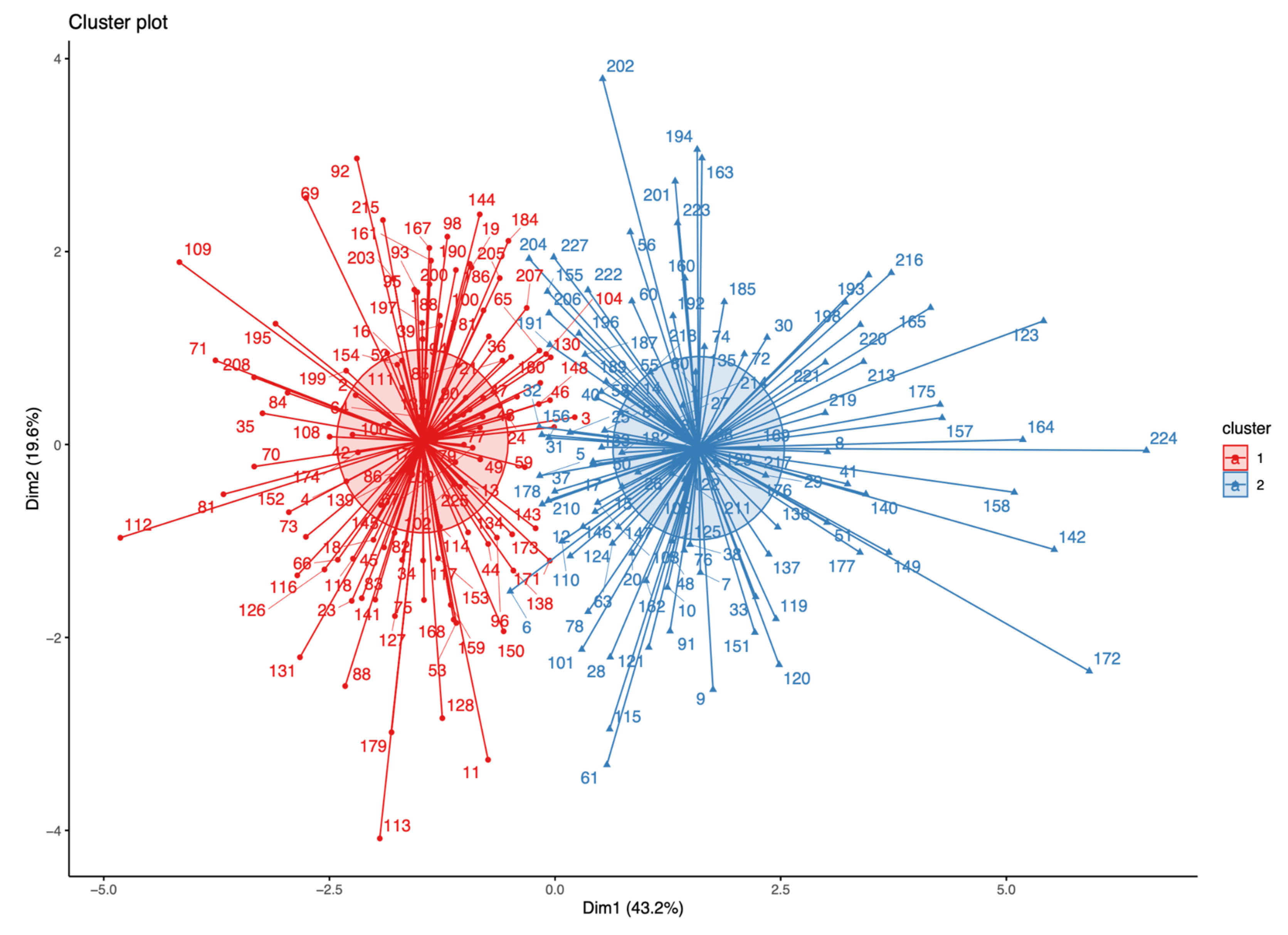Profiling the Physical Performance of Young Boxers with Unsupervised Machine Learning: A Cross-Sectional Study
Abstract
1. Introduction
2. Materials and Methods
2.1. Study Design
2.2. Setting
2.3. Participants
2.4. Variables
2.5. Data Sources/Measurement
2.5.1. Maximal Isometric Handgrip Strength (HG)
2.5.2. Countermovement Jump (CMJ)
2.5.3. Punch Velocity (PV)
2.5.4. Punch Impact Force (PIF)
2.6. Sample Size
2.7. Statistical Analysis
3. Results
3.1. Descriptive Data
3.2. Main Results
4. Discussion
4.1. Limitations and Future Directions
4.2. Interpretation
4.3. Generalizability
5. Conclusions
Supplementary Materials
Author Contributions
Funding
Institutional Review Board Statement
Informed Consent Statement
Data Availability Statement
Acknowledgments
Conflicts of Interest
References
- Morales-Rosillo, D.G.; Petro, J.L.; Bonilla, D.A. Proceso civilizatorio, violencia y deportes de combate; revisión integradora del boxeo vs artes marciales mixtas. [Civilizing process, violence, and combat sports; integrative review of boxing and mixed martial arts]. RICYDE Rev. Int. Cienc. Deporte 2019, 15, 413–432. [Google Scholar] [CrossRef]
- Chaabène, H.; Tabben, M.; Mkaouer, B.; Franchini, E.; Negra, Y.; Hammami, M.; Amara, S.; Chaabène, R.B.; Hachana, Y. Amateur boxing: Physical and physiological attributes. Sports Med. 2015, 45, 337–352. [Google Scholar] [CrossRef]
- Merlo, R. La Preparación Física en el Boxeo; Rawson-Playa Union: Chubut, Argentina, 2014. [Google Scholar]
- Lenetsky, S.; Harris, N.; Brughelli, M. Assessment and Contributors of Punching Forces in Combat Sports Athletes. Strength Cond. J. 2013, 35, 1–7. [Google Scholar] [CrossRef]
- Pierce, J.; Reinbold, K.; Lyngard, B.; Goldman, R.; Pastore, C. Direct Measurement of Punch Force During Six Professional Boxing Matches. J. Quant. Anal. Sports 2007, 2, 3. [Google Scholar] [CrossRef]
- Smith, M.S. Physiological profile of senior and junior England international amateur boxers. J. Sports Sci. Med. 2006, 5, 74–89. [Google Scholar]
- Atha, J.; Yeadon, M.R.; Sandover, J.; Parsons, K.C. The damaging punch. Br. Med. J. (Clin. Res. Ed.) 1985, 291, 1756–1757. [Google Scholar] [CrossRef]
- Walilko, T.J.; Viano, D.C.; Bir, C.A. Biomechanics of the head for Olympic boxer punches to the face. Br. J. Sports Med. 2005, 39, 710–719. [Google Scholar] [CrossRef]
- Kimm, D.; Thiel, D.V. Hand Speed Measurements in Boxing. Procedia Eng. 2015, 112, 502–506. [Google Scholar] [CrossRef]
- Guidetti, L.; Musulin, A.; Baldari, C. Physiological factors in middleweight boxing performance. J. Sports Med. Phys. Fit. 2002, 42, 309–314. [Google Scholar]
- Kravitz, L.; Greene, L.; Burkett, Z.; Wongsathikun, J. Cardiovascular response to punching tempo. J. Strength Cond. Res. 2003, 17, 104–108. [Google Scholar] [CrossRef]
- Piorkowski, B.A.; Lees, A.; Barton, G.J. Single maximal versus combination punch kinematics. Sports Biomech. 2011, 10, 1–11. [Google Scholar] [CrossRef] [PubMed]
- Valentino, B.; Esposito, L.C.; Fabozzo, A. Electromyographic activity of a muscular group in movements specific to boxing. J. Sports Med. Phys. Fit. 1990, 30, 160–162. [Google Scholar]
- Davis; Wittekind; Beneke. Amateur Boxing: Activity Profile of Winners and Losers. Int. J. Sports Physiol. Perform. 2013, 8, 84–91. [Google Scholar] [CrossRef]
- Filimonov, V.I.; Koptsev, K.N.; Husyanov, Z.M.; Nazarov, S.S. Boxing: Means of increasing strength of the punch. Strength Cond. J. 1985, 7, 65. [Google Scholar] [CrossRef]
- Muazu Musa, R.; Abdul Majeed, P.P.; Taha, Z.; Chang, S.W.; Ab Nasir, A.F.; Abdullah, M.R. A machine learning approach of predicting high potential archers by means of physical fitness indicators. PLoS ONE 2019, 14, e0209638. [Google Scholar] [CrossRef]
- Abraldes, J.A.; Conte Marín, L.; Manzano-Sánchez, D.; Gómez-López, M.; Sánchez-Alcaraz, B.J. A cluster analysis of high-performance female team players’ perceived motivational climate: Implications on perceived motor competence and autonomous behaviour. PLoS ONE 2022, 17, e0278572. [Google Scholar] [CrossRef]
- Sarvestan, J.; Svoboda, Z.; Alaei, F.; Mulloy, F. Analysis of Whole-Body Coordination Patterning in Successful and Faulty Spikes Using Self-Organising Map-Based Cluster Analysis: A Secondary Analysis. Sensors 2021, 21, 1345. [Google Scholar] [CrossRef]
- Bonilla, D.A.; Peralta, J.O.; Bonilla, J.A.; Urrutia-Mosquera, W.; Vargas-Molina, S.; Cannataro, R.; Petro, J.L. Morphology, body composition and maturity status of young Colombian athletes from the Urabá subregion: A k-Medoids and hierarchical clustering analysis. J. Hum. Sport Exerc. 2020, 15, S1367–S1386. [Google Scholar]
- Vandenbroucke, J.P.; Von Elm, E.; Altman, D.G.; Gøtzsche, P.C.; Mulrow, C.D.; Pocock, S.J.; Poole, C.; Schlesselman, J.J.; Egger, M. Mejorar la comunicación de estudios observacionales en epidemiología (STROBE): Explicación y elaboración. J. Gac. Sanit. 2009, 23, 158e1–158e28. [Google Scholar] [CrossRef]
- World Medical Association World Medical Association Declaration of Helsinki: Ethical principles for medical research involving human subjects. J. Postgrad. Med. 2002, 48, 206–208.
- Caldwell, L.S.; Chaffin, D.B.; Dukes-Dobos, F.N.; Kroemer, K.H.; Laubach, L.L.; Snook, S.H.; Wasserman, D.E. A proposed standard procedure for static muscle strength testing. Am. Ind. Hyg. Assoc. J. 1974, 35, 201–206. [Google Scholar] [CrossRef]
- Sale, D. Physiological Testing of the High-Performance Athlete. In Testing Strength and Power, 2nd ed.; Mac Dougall, J.D., Wenger, H.A., Green, H.J., Eds.; Human Kinetics: Champaign, IL, USA, 1991. [Google Scholar]
- Edwards, R.H.; Young, A.; Hosking, G.P.; Jones, D.A. Human skeletal muscle function: Description of tests and normal values. Clin. Sci. Mol. Med. 1977, 52, 283–290. [Google Scholar] [CrossRef]
- Zeh, J.; Hansson, T.; Bigos, S.; Spengler, D.; Battié, M.; Wortley, M. Isometric strength testing. Recomm. Based A Stat. Anal. Procedure. Spine 1986, 11, 43–46. [Google Scholar] [CrossRef]
- Brown, L.; Weir, J. ASEP Procedures recommendation I: Accurate assessment of muscular strength and power. J. Exerc. Physiol. Online 2001, 4, 1–21. [Google Scholar]
- Chaffin, D.B.; Herrin, G.D.; Keyserling, W.M. Preemployment strength testing: An updated position. J. Occup. Med. Off. Publ. Ind. Med. Assoc. 1978, 20, 403–408. [Google Scholar]
- Keyserling, W.M.; Herrin, G.D.; Chaffin, D.B. Isometric Strength Testing as a Means of Controlling Medical Incidents on Strenuous Jobs. J. Occup. Med. 1980, 22, 332–336. [Google Scholar] [CrossRef] [PubMed]
- Stanley, E.; Thomson, E.; Smith, G.; Lamb, K.L. An analysis of the three-dimensional kinetics and kinematics of maximal effort punches among amateur boxers. Int. J. Perform. Anal. Sport 2018, 18, 835–854. [Google Scholar] [CrossRef]
- Ruddock, A.; Winter, E. Jumping depends on impulse not power. J. Sports Sci. 2015, 34, 584–585. [Google Scholar] [CrossRef]
- Bosco, C.; Riu, J.M.P. La valoración de la Fuerza con el Test de Bosco; Paidotribo: Barcelona, Spain, 1994. [Google Scholar]
- Winkelman, N. Assessing athletic qualities. In Sports Injury Prevention and Rehabilitation. Integrating Medicine and Science for Performance Solutions; Lewindon, D.J.a.D., Ed.; Routledge: New York, NY, USA, 2016. [Google Scholar]
- Glatthorn, J.F.; Gouge, S.; Nussbaumer, S.; Stauffacher, S.; Impellizzeri, F.M.; Maffiuletti, N.A. Validity and reliability of Optojump photoelectric cells for estimating vertical jump height. J. Strength Cond. Res. 2011, 25, 556–560. [Google Scholar] [CrossRef] [PubMed]
- Asmussen, E.; Bonde-Petersen, F. Storage of elastic energy in skeletal muscles in man. Acta Physiol. Scand. 1974, 91, 385–392. [Google Scholar] [CrossRef] [PubMed]
- Jiménez-Reyes, P.; Cuadrado-Peñafiel, V.; González-Badillo, J.J. Aplicación del CMJ para el control del entrenamiento en las sesiones de velocidad. Cult. Cienc. Y Deporte 2011, 6, 105–112. [Google Scholar] [CrossRef]
- Dunn, E.; Humberstone, C.; Iredale, F.; Blazevich, A. A damaging punch: Assessment and application of a method to quantify punch performance. Transl. Sports Med. 2019, 2, 146–152. [Google Scholar] [CrossRef]
- Omcirk, D.; Vetrovsky, T.; Padecky, J.; Vanbelle, S.; Malecek, J.; Tufano, J.J. Punch Trackers: Correct Recognition Depends on Punch Type and Training Experience. Sensors 2021, 21, 2968. [Google Scholar] [CrossRef]
- Smith, M.S.; Dyson, R.J.; Hale, T.; Janaway, L. Development of a boxing dynamometer and its punch force discrimination efficacy. J. Sports Sci. 2000, 18, 445–450. [Google Scholar] [CrossRef]
- Merlo, R.D.; Rodríguez-Chávez, J.Á. Post-activation performance enhancement with bench press or landmine on straight punch strength. Rev. Cienc. Y Tecnol. En La Cult. Física 2021, 16, 509–523. [Google Scholar]
- Damián Merlo, R.; Rodríguez Chávez, J.Á. Mejora del rendimiento post-activación con banco plano o landmine en la fuerza del golpe recto. Rev. Cienc. Y Tecnol. En La Cult. Física 2021, 16, 509–523. [Google Scholar]
- Ruscio, J.; Gera, B.L. Generalizations and Extensions of the Probability of Superiority Effect Size Estimator. Multivar. Behav. Res. 2013, 48, 208–219. [Google Scholar] [CrossRef]
- Uanhoro, J.O. Probability of superiority for comparing two groups of clusters. Behav. Res. Methods 2023, 55, 646–656. [Google Scholar] [CrossRef] [PubMed]
- Cardozo, L.A.; Reina-Monroy, J.L.; Peña-Ibagón, J.C.; Florez-Escobar, W.; Castillo-Daza, C.A.; Bonilla, D.A. Physical self-concept in university students: Generating profiles with hierarchical classification on principal components. Retos 2023, 48, 167–177. [Google Scholar] [CrossRef]
- Bonilla, D.A.; Sanchez-Rojas, I.A.; Mendoza-Romero, D.; Moreno, Y.; Koci, J.; Gomez-Miranda, L.M.; Rojas-Valverde, D.; Petro, J.L.; Kreider, R.B. Profiling Physical Fitness of Physical Education Majors Using Unsupervised Machine Learning. Int. J. Environ. Res. Public Health 2022, 20, 146. [Google Scholar] [CrossRef]
- Bonilla, D.A.; Peralta-Alzate, J.O.; Bonilla-Henao, J.A.; Urrutia-Mosquera, W.; Cannataro, R.; Kočí, J.; Petro, J.L. Unsupervised machine learning analysis of the anthropometric characteristics and maturity status of young Colombian athletes. J. Phys. Educ. Sport 2022, 22, 256–265. [Google Scholar] [CrossRef]
- Jin, X.; Han, J. K-Medoids Clustering. In Encyclopedia of Machine Learning; Springer: Berlin/Heidelberg, Germany, 2011; pp. 564–565. [Google Scholar] [CrossRef]
- Brock, G.; Pihur, V.; Datta, S.; Datta, S. clValid: AnRPackage for Cluster Validation. J. Stat. Softw. 2008, 25, 1–22. [Google Scholar] [CrossRef]
- Team, R.C. R: A Language and Environment for Statistical Computing; R Core Team: Vienna, Austria, 2013. [Google Scholar]
- Girodet, P.; Vaslin, P.; Dabonneville, M.; Lacouture, P. Two-dimensional kinematic and dynamic analysis of a karate straight punch. Comput. Methods Biomech. Biomed. Eng. 2005, 8, 117–118. [Google Scholar] [CrossRef]
- Dunn, E.C.; Humberstone, C.E.; Franchini, E.; Iredale, K.F.; Blazevich, A.J. Relationships Between Punch Impact Force and Upper- and Lower-Body Muscular Strength and Power in Highly Trained Amateur Boxers. J. Strength Cond. Res. 2022, 36, 1019–1025. [Google Scholar] [CrossRef] [PubMed]
- Rimkus, L.; Satkunskiene, D.; Kamandulis, S.; Bruzas, V. Lower-body power in boxers is related to activity during competitive matches. Int. J. Perform. Anal. Sport 2019, 19, 342–352. [Google Scholar] [CrossRef]
- Yi, W.; Chen, C.; Zhou, Z.; Cui, W.; Wang, D. Acute effects of ballistic versus heavy-resistance exercises on countermovement jump and rear-hand straight punch performance in amateur boxers. BMC Sports Sci. Med. Rehabil. 2022, 14, 161. [Google Scholar] [CrossRef]
- Loturco, I.; Nakamura, F.Y.; Artioli, G.G.; Kobal, R.; Kitamura, K.; Cal Abad, C.C.; Cruz, I.F.; Romano, F.; Pereira, L.A.; Franchini, E. Strength and Power Qualities Are Highly Associated With Punching Impact in Elite Amateur Boxers. J. Strength Cond. Res. 2016, 30, 109–116. [Google Scholar] [CrossRef]
- Beattie, K.; Ruddock, A.D. The Role of Strength on Punch Impact Force in Boxing. J. Strength Cond. Res. 2022, 36, 2957–2969. [Google Scholar] [CrossRef]
- Loturco, I.; Pereira, L.A.; Kobal, R.; Fernandes, V.; Reis, V.P.; Romano, F.; Alves, M.; Freitas, T.T.; McGuigan, M. Transference Effect of Short-Term Optimum Power Load Training on the Punching Impact of Elite Boxers. J. Strength Cond. Res. 2021, 35, 2373–2378. [Google Scholar] [CrossRef]
- Ramírez-García, C.M.; Harasymowicz, J.; Viramontes, J.; Alvear-Ordenes, I.; Vazquez, F. Assessment of hand grip strength in Mexican boxers by training phase. Arch. Budo 2010, 6, 33–38. [Google Scholar]
- Bruzas, V.; Mockus, P.; Cepulenas, A.; Maciulis, V. Lietuvos rinktinės boksininkų kūno sudėjimo, atletinio ir specialiojo fizinio parengtumo tyrimo duomenys ir jų sąsajos ryšiai. [Data of the body composition athletic and special physical fitness and their interrelation in Lithuanian national team boxers]. Sports Moksl. 2008, 54, 50–57. [Google Scholar]
- Dinu, D.; Louis, J. Biomechanical Analysis of the Cross, Hook, and Uppercut in Junior vs. Elite Boxers: Implications for Training and Talent Identification. Front. Sports Act. Living 2020, 2, 598861. [Google Scholar] [CrossRef]
- Di Stasi, M.; Buscarini, L.; Livraghi, T.; Giorgio, A.; Salmi, A.; De Sio, I.; Brunello, F.; Solmi, L.; Caturelli, E.; Magnolfi, F.; et al. Percutaneous ethanol injection in the treatment of hepatocellular carcinoma. A multicenter survey of evaluation practices and complication rates. Scand J. Gastroenterol. 1997, 32, 1168–1173. [Google Scholar] [CrossRef]
- Cid-Calfucura, I.; Herrera-Valenzuela, T.; Franchini, E.; Falco, C.; Alvial-Moscoso, J.; Pardo-Tamayo, C.; Zapata-Huenullán, C.; Ojeda-Aravena, A.; Valdés-Badilla, P. Effects of Strength Training on Physical Fitness of Olympic Combat Sports Athletes: A Systematic Review. Int. J. Environ. Res. Public Health 2023, 20, 3516. [Google Scholar] [CrossRef] [PubMed]
- Malina, R.; Rogol, A.; Cumming, S.; Coelho-e-Silva, M.; Figueiredo, A. Biological maturation of youth athletes: Assessment and implications. Br. J. Sports Med. 2015, 49, 852–859. [Google Scholar] [CrossRef] [PubMed]
- Manske, R.; Reiman, M. Functional performance testing for power and return to sports. Sports Health 2013, 5, 244–250. [Google Scholar] [CrossRef]



| Variable | Female (n = 44) | Male (n = 183) | p Value | ρ | ||
|---|---|---|---|---|---|---|
| Median | IQR (Q3 − Q1) | Median | IQR (Q3 − Q1) | |||
| Age (years) | 15 | 15.25 − 15 | 15 | 16 − 15 | 0.157 | 0.435 |
| BM (kg) | 57.80 | 63.00 − 49.95 | 60.80 | 73.10 − 53.55 | 0.004 | 0.360 |
| CMJ (cm) | 27.90 | 25.72 − 19.15 | 29.60 | 34.25 − 25.00 | <0.001 | 0.193 |
| HG (kg) | 32.20 | 30.00 − 23.90 | 34.80 | 38.45 − 30.10 | <0.001 | 0.153 |
| PIF (kg) | 57.63 | 63.14 − 42.75 | 54.42 | 69.61 − 43.98 | 0.288 | 0.448 |
| PIF/BM | 0.99 | 1.17 − 0.66 | 0.85 | 1.16 − 0.65 | 0.594 | 0.474 |
| PIF/HG | 1.77 | 2.77 − 1.62 | 1.61 | 1.98 − 1.24 | 0.001 | 0.344 |
| PIF/(BM+HG) | 0.63 | 0.78 − 0.48 | 0.56 | 0.72 − 0.43 | 0.107 | 0.421 |
| PV (m·s−1) | 8.30 | 9.77 − 6.40 | 8.40 | 10.20 – 6.80 | 0.459 | 0.464 |
| Variable | Profile 1 (n = 118) | Profile 2 (n = 109) | p Value | ρ | ||
|---|---|---|---|---|---|---|
| Median | IQR (Q3 − Q1) | Median | IQR (Q3 − Q1) | |||
| Sex (n, %) | 17 F (14.4%); 101 M (85.5%) | 27 F (24.7%); 82 M (75.2%) | ||||
| Age (years) | 15 | 16 − 15 | 15 | 16 − 15 | 0.562 | 0.479 |
| BM (kg) | 65.9 | 80.67 − 59.20 | 53.9 | 59.80 − 50.20 | <0.001 | 0.197 |
| CMJ (cm) | 26.6 | 32.20 − 22.92 | 29.00 | 33.30 − 24.60 | 0.041 | 0.421 |
| HG (kg) | 35.2 | 40.40 − 29.55 | 32.1 | 35.50 − 26.70 | <0.001 | 0.362 |
| PIF (kg) | 45.27 | 50.02 − 37.80 | 67.75 | 76.81 − 57.63 | <0.001 | 0.118 |
| PIF/BM | 0.66 | 0.78 − 0.54 | 1.17 | 1.42 − 1.01 | <0.001 | 0.017 |
| PIF/HG | 1.32 | 1.55 − 1.06 | 2.03 | 2.72 − 1.77 | <0.001 | 0.079 |
| PIF/(BM+HG) | 0.44 | 0.50 − 0.36 | 0.75 | 0.89 − 0.66 | <0.001 | 0.008 |
| PV (m·s−1) | 7.65 | 9.67 − 6.40 | 8.70 | 10.60 − 7.30 | 0.010 | 0.401 |
Disclaimer/Publisher’s Note: The statements, opinions and data contained in all publications are solely those of the individual author(s) and contributor(s) and not of MDPI and/or the editor(s). MDPI and/or the editor(s) disclaim responsibility for any injury to people or property resulting from any ideas, methods, instructions or products referred to in the content. |
© 2023 by the authors. Licensee MDPI, Basel, Switzerland. This article is an open access article distributed under the terms and conditions of the Creative Commons Attribution (CC BY) license (https://creativecommons.org/licenses/by/4.0/).
Share and Cite
Merlo, R.; Rodríguez-Chávez, Á.; Gómez-Castañeda, P.E.; Rojas-Jaramillo, A.; Petro, J.L.; Kreider, R.B.; Bonilla, D.A. Profiling the Physical Performance of Young Boxers with Unsupervised Machine Learning: A Cross-Sectional Study. Sports 2023, 11, 131. https://doi.org/10.3390/sports11070131
Merlo R, Rodríguez-Chávez Á, Gómez-Castañeda PE, Rojas-Jaramillo A, Petro JL, Kreider RB, Bonilla DA. Profiling the Physical Performance of Young Boxers with Unsupervised Machine Learning: A Cross-Sectional Study. Sports. 2023; 11(7):131. https://doi.org/10.3390/sports11070131
Chicago/Turabian StyleMerlo, Rodrigo, Ángel Rodríguez-Chávez, Pedro E. Gómez-Castañeda, Andrés Rojas-Jaramillo, Jorge L. Petro, Richard B. Kreider, and Diego A. Bonilla. 2023. "Profiling the Physical Performance of Young Boxers with Unsupervised Machine Learning: A Cross-Sectional Study" Sports 11, no. 7: 131. https://doi.org/10.3390/sports11070131
APA StyleMerlo, R., Rodríguez-Chávez, Á., Gómez-Castañeda, P. E., Rojas-Jaramillo, A., Petro, J. L., Kreider, R. B., & Bonilla, D. A. (2023). Profiling the Physical Performance of Young Boxers with Unsupervised Machine Learning: A Cross-Sectional Study. Sports, 11(7), 131. https://doi.org/10.3390/sports11070131








